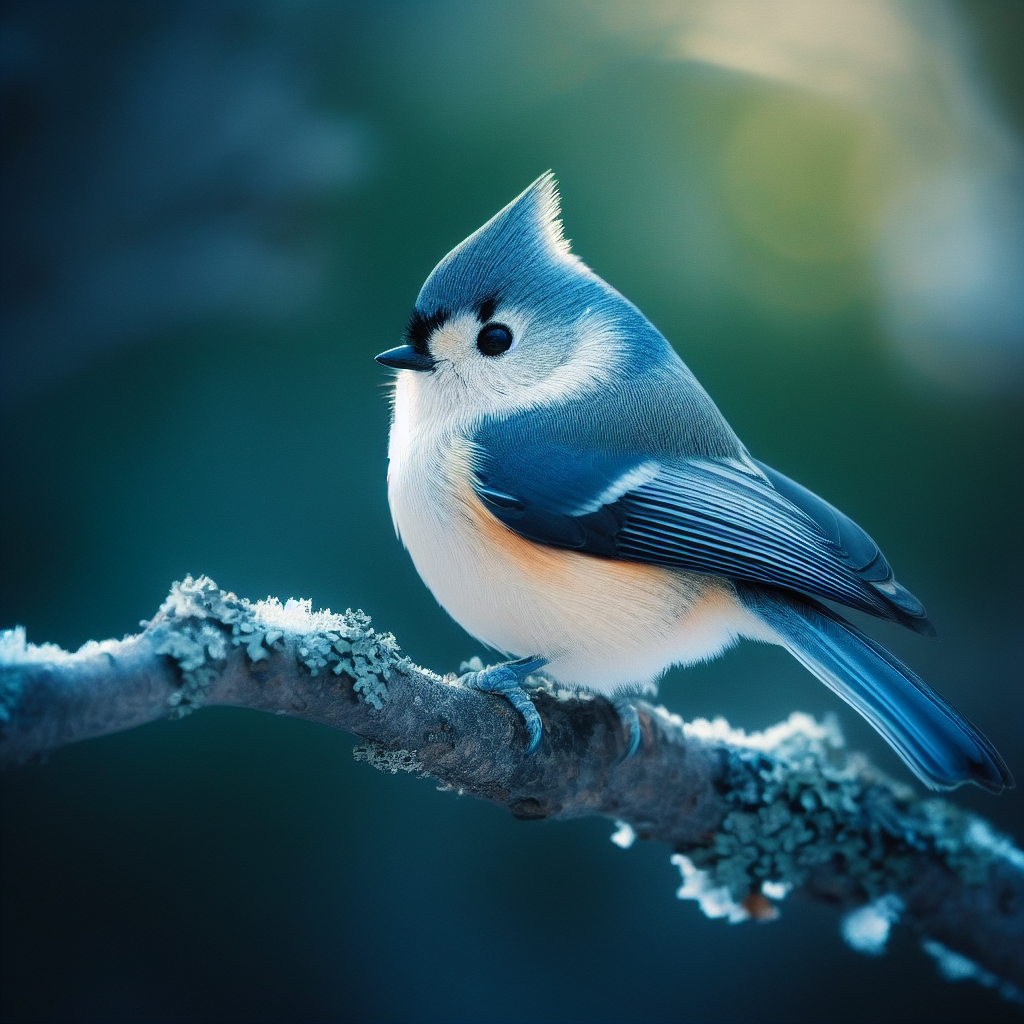Most beautiful small birds - Sykalo Eugen 2024
Tufted Titmouse (Baeolophus bicolor)
Identification:
- Species name: Tufted Titmouse
- Scientific name: Baeolophus bicolor
- Family: Paridae (Tits)
- Order: Passeriformes (Songbirds)
- Subclass: Neornithes (Modern birds)
- Class: Aves (Birds)
Description:
- Size: Compact and robust, about 15-16 cm (5.9-6.3 in) long with a wingspan of 21-24 cm (8.3-9.4 in).
- Body shape: Chubby and rounded, with a short, thick neck, a plump body, a short, squared tail, and a distinctive black crest of feathers that rises and falls with emotion.
- Plumage color:
Upperparts: Soft gray, tinged with olive on the back and wings.
Underparts: Lighter gray, fading to white on the belly.
Black bib under the chin extends up to the base of the beak.
Short, black beak perfect for cracking seeds and nuts.
Strong, pinkish-gray legs for navigating branches and foraging on the ground.
Large, dark brown eyes that scan for food and potential threats.
Behavior:
- Method of feeding: Omnivorous, eating a variety of seeds, nuts, insects, spiders, and berries. Forages on branches, twigs, and the ground, often caching food for later.
- Reproduction: Builds cup-shaped nests in cavities, often abandoned woodpecker holes or birdhouses. Lays 4-8 white eggs with dark speckles. Both parents care for the young.
- Movement: Resident in most of its range, with some local movements in response to food availability.
- Communication: Loud, clear whistles and calls, with variations used for alarm, foraging, and mating. Males have a complex song used for territorial defense and attracting mates.
Ecology:
- Habitat: Deciduous and mixed forests, woodlands, parks, and gardens. Prefers areas with mature trees and plenty of hiding places.
- Diet: Seeds, nuts, insects, spiders, berries, and other small fruits.
- Hunting methods: Gleans insects and spiders from leaves and branches, pecks for hidden prey in bark crevices, and forages on the ground for fallen seeds and fruit.
Distribution: Found across eastern North America, from southern Canada to the Gulf Coast and west to the Great Plains.

The Tufted Titmouse, a feathered dynamo painting the deciduous forests with flashes of gray and a crest like a tiny crown. This resident of oak and maple might seem like a simple seed muncher at first glance, but beneath its unassuming plumage and seemingly cheerful calls lies a treasure trove of surprising facts and adaptations that will transform this forest sprite into a captivating acrobatic explorer, hidden feast master, and unexpected social networker in your eyes.
Masters of the Canopy Labyrinth: Forget clumsy hops; Tufted Titmice reign supreme in the domain of sun-dappled leaves and towering branches. Their powerful legs and surprisingly acrobatic skills propel them through the foliage with breathtaking agility, twisting and turning like feathered parkour experts on miniature trapezes. Imagine them as canopy gymnasts with built-in miniature climbing shoes and an innate love for high-wire adventures.
Hidden Feasting Technique: Don't underestimate their dietary flexibility! While seeds and nuts are a staple, Tufted Titmice are opportunistic omnivores, readily adapting their menu to seasonal bounty. From juicy fruits and tender shoots to insects and even the occasional small lizard, their varied appetite keeps them fueled for energetic foraging sessions. Think of them as feathered forest gourmands with built-in miniature buffets hidden within the leafy maze.
Singing with Curious Spirit: Their calls aren't just chirps and whistles. Tufted Titmice possess a distinctive and surprisingly inquisitive repertoire, with clear, piping songs, intricate trills, and even a signature "peter-peter-peter" duet call that echoes melodically through the branches. Their voices rise above the forest like feathered birdwatchers, asking and answering questions about the hidden corners of their leafy domain.
Unexpected Social Networkers: They're not always solitary singers. During harsh winters and foraging adventures, Tufted Titmice often form loose and surprisingly vocal flocks, flitting through the foliage in waves of gray feathers and echoing calls. These feathered socialites, in synchronized searches and intricate communication networks, paint fleeting patterns of unity and shared knowledge across the forest canopy.
Champions of Ecosystem Health: They're not just colorful residents. Tufted Titmice play a vital role in the health of deciduous ecosystems. Their seed dispersal contributes to plant reforestation, while their insect feasting controls pest populations, making them feathered forest doctors with built-in miniature seed-spreading tools and environmental beautification kits.
Cultural Charmers: Across North America, the Tufted Titmouse has held diverse cultural significance. In some regions, its presence in gardens is seen as a symbol of good luck and cheerfulness. In others, its crest-like headwear inspires admiration for its regal spirit and connection to nature's hidden wisdom.
Unexpected Regional Variations: Did you know? Not all Tufted Titmice are the same! Different populations across their vast range show subtle variations in plumage color and call patterns, adding a touch of feathered diversity to this adaptable species.